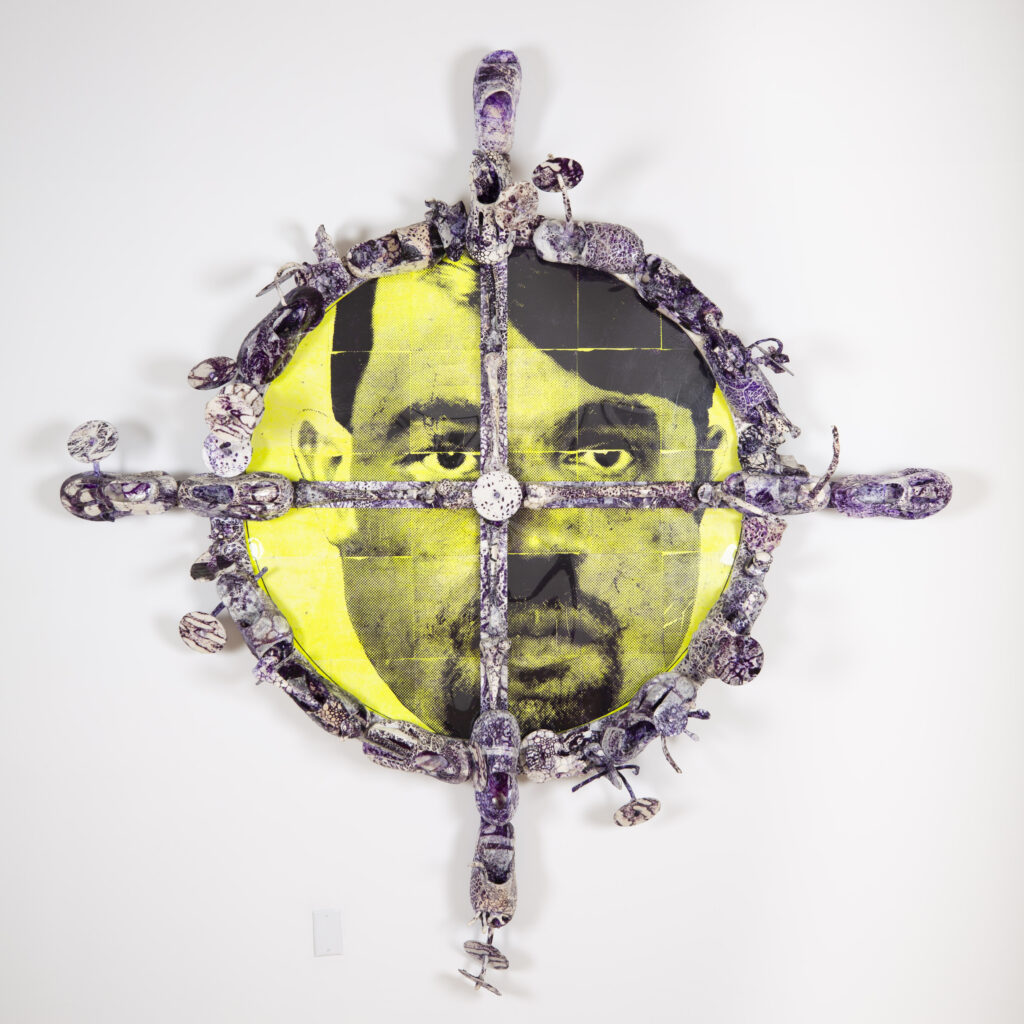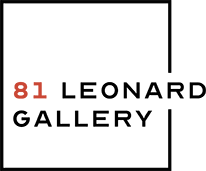
The distressing truth behind an exhibit about antisemitism — it’s always timely
by Stav Ziv, The Forward
July 5, 2024
The first thing you see when you walk into 81 Leonard Gallery in Tribeca is an uncanny amalgamation of two faces: Adolf Hitler and Kanye “Ye” West. Is it a powerful dictator or a popular rapper? It’s both and neither, but a face and font of antisemitism regardless.
Marina Heintze’s “Yitler” is like an artistic onion — peeling back one layer reveals another and each pungent revelation adds to the sting. Bacterial patterns remind viewers of propaganda that has long associated Jews with disease. Tattoo paper and distorted shoes conjure images of Auschwitz.
Two other pieces by Heintze greet passersby from a front window looking out onto Lower Manhattan, home to dozens of art galleries and growing. One features a portrait of Heintze’s grandmother, who fled Vienna and the Nazis, and the other an array of literal dog whistles. All three are part of a series conceived of before Hamas launched its attack on Oct. 7. But the subject matter, Heintze says, is unfortunately “always on trend.”
Making art is “the only way for me to express either my disdain or my point of view and feel maybe that I can do something with that,” said Heintze, who grew up in Tribeca but now lives and works in Los Angeles. “Antisemitism is a disease and that’s what I wanted to relate to with the material that I chose,” she added. “And if it’s a disease, there has to be a cure.”
Heintze doesn’t claim that art is that cure, but for her and several of her colleagues participating in the “Artists on Antisemitism” exhibition (on view through Aug. 30), it is a necessary outlet for expression and a chance to find one another at a time when fellowship isn’t forthcoming everywhere in the art world.
“My whole idea for the show was that it had to be something that would help everybody,” said Yona Verwer, one of the curators.
‘Antisemitism didn’t start with Oct. 7’
Verwer began reaching out to artists she knew in Israel in the aftermath of Oct. 7 to say she was thinking of them and to offer support. In return, she got art and stories: “I thought, ‘We have to do something. We have to do a show about the aftermath.’”
That “something” turned into multiple planned shows, starting with “Artists on Antisemitism,” which became more pressing as protests and antisemitic incidents escalated across the country.
The show was curated by Verwer; Jewish Art Salon members Judith Joseph and Ronit Levin Delgado; and Hannah Rothbard and Nancy Pantirer, director and founder of 81 Leonard Gallery, respectively, both Jewish artists themselves. It’s the second such collaboration between the Jewish Art Salon and the gallery, after 2022’s “PAUSE: Jewish Heritage Month/Ways of Being,” which highlighted “the multiplicities of Jewish identities,” Rothbard said.
The submissions the curators received in response to this call — framed intentionally around the current surge of antisemitism rather than the Israel-Hamas war — also reflected a diverse group of artists with different perspectives. In the end, the curators chose works by 21 artists from all over the U.S. and Israel, spanning generations, and working in mediums including photography, painting, paper collage, woodcut, mixed media, and even Lego.
“Antisemitism didn’t start with Oct. 7. So this is a conversation that has been needed to be had regardless,” said Rothbard. But it did feel particularly important to offer the space and opportunity at a time when, she said, “the New York art world seems to treat Israelis and Jewish artists like they are the State of Israel and like everyone is a stand-in for the conflict.”
As the curators put together the show, they realized much of the work grappled with dualities, like “caution versus courage,” Rothbard said. That tension fills the gallery, as does that between past and present, tragedy and joy, fear and pride, despair and optimism. Each work contends with antisemitism in its own way and on its own scale.
“Neck Piece,” for example, is a pair of small paintings — eight by eight inch squares — by Goldie Gross. Both are close-up self-portraits that zoom in on the hollow beneath the artist’s chin and let viewers spot a subtle difference. On the left, a necklace is tucked under Gross’ collar, mostly invisible behind her black shirt. On the right, the gold chain sits in plain view, Hebrew letters spelling out her name.
Read the full article here.
